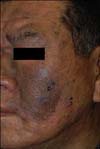Dear Editor:
Eosinophilic pustular folliculitis (EPF) is an inflammatory disease that is characterized by pruriticfollicular papules and pustules. Several reported cases showing an association between EPF and hematological diseases as well as a high proportion of EPF cases in HIV-positive patients suggest that immunological aberrations might play a role in the development of EPF. A 56-year-old man who underwent kidney transplantation 18 years ago presented with multiple papules on cheeks (Fig. 1). He was treated with cyclosporine (150 mg daily) and mycophenolate mofetil (MMF; 1,500 mg daily). Blood analysis yielded a white blood cell count of 12,000 cells/mm3 (12.1% eosinophils). Tests for HIV were also negative. Skin biopsies led to the diagnosis of chronic active folliculitis of the dermis with eosinophilic and lymphocytic infiltration (Fig. 2). With the results suggesting a diagnosis of EPF, we treated the patient with 50 mg per day dapsone. After 3 weeks, the lesions showed gradual resolution. According to recent reports, shifts in the T-helper type 2 (Th2) cytokine expression profile are believed to underlie the pathogenesis. This notion is compatible with the observation that interleukin-5 levels increase in the serum of patients with EPF. On the basis of this theory, cyclosporine and tacrolimus, which demonstrate inhibitory effects on the transcription of proinflammatory cytokine genes, were used to treat EPF; successful results had been obtained1,2. In this case, however, although the patient had used cyclosporine and MMF for many years, EPF still developed. This indicates that aberrant Th2 immune responses alone cannot explain the pathogenesis of EPF. In addition, members of the prostaglandin family operate downstream of cyclooxygenase can be successfully treated with indomethacin, a cyclooxygenase inhibitor3. A previous study reported that a drug of the same class, naproxen, also had a therapeutic effect on EPF4. The symptoms of our patient were alleviated after the administration of dapsone. This indicates that EPF in patients using immunosuppressants can be treated with drugs having anti-inflammatory effects. Dapsone functions as an anti-inflammatory and immunomodulatory agent, and has also been shown as an efficacious treatment option5. The pathogenesis of this case is thought to be similar to those of cases that developed after bone marrow or stem cell transplantation in HIV-negative patients. These patients tended to develop EPF after transplantation, even when the underlying hematologic diseases were in remission. The one thing in common was that used immunosuppressant. Moreover, although the duration of treatment was different, EPF developed after immunosuppressant administration in all cases. There are also some differences in etiology because solid organ transplantations do not cause critical immunological changes similar to that caused by bone marrow or stem cell transplantation. Ironically, the use of immunosuppressants, which are administered to organ transplant recipients, may explain why there has been no report on EPF in transplant recipients until now. As the survival outcomes of transplant recipients improve in the future, EPF infiltration in transplant patients may increasingly occur. For such cases, antiinflammatory drugs such as dapsone and indomethacin should be the first treatment option.The patient was fully informed and consented to the publication of the case.




 PDF
PDF ePub
ePub Citation
Citation Print
Print




 XML Download
XML Download